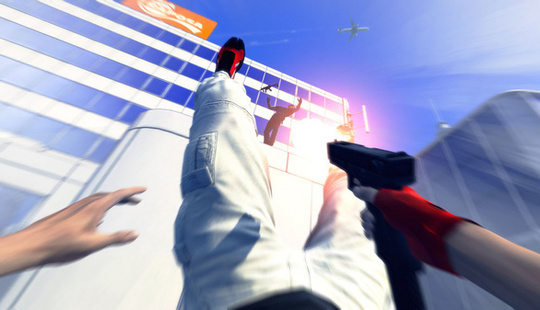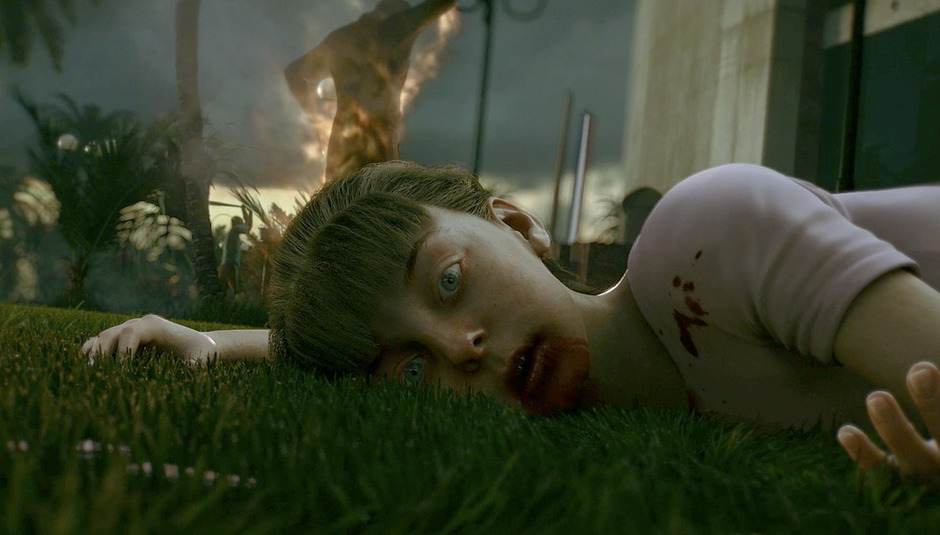Apologies for the no-show in August. I was in the Lake District. Not a great deal of gaming up in those hills. Besides, August was a quiet month indeed, even for the hardcore gamer – until the release of Deus Ex: Human Revolution, anyway. But more on that title, later.
PREVIEWS
Between now and Christmas a veritable buffet of mouth-watering games are hitting the market. Batman: Arkham City finally arrives on October 21, on multiple platforms; PlayStation 3 exclusive Uncharted 3: Drake’s Deception – the latest in an award-winning series of Indiana Jones-like explore-em-ups – lands in November; and there’s the small matter of The Elder Scrolls V: Skyrim, which is sure to soak up gaming time like the swords-and-spells masterpiece that was its predecessor, Oblivion (albeit hopefully with slightly less-wooden facial animation). But just around the corner is a Rather Big Deal Indeed (and I’m sorry, PlayStation owners, but it is): Gears of War 3, exclusive to Xbox 360, released on September 20.
GoW3 has received over a million pre-orders. It is the climax to a story that began as just another grunts-with-guns adventure, man against beasties – in this case, the Locust, a race of humanoids (well, some of them are humanoid; some scuttle around like insects and explode…) indigenous to the planet Sera, settled on by humanity in… oooh, I dunno. Sometime in the future. Probably. Or it’s a parallel universe. Y’know, it’s sci-fi. But by the end of the second game, the player was facing a rather less simple scenario: just who was the aggressor here? Us, or them? And with the Locust fighting a civil war of their own, just as the human side had (the Pendulum Wars… keeping up? Don’t worry, the story doesn’t stand in the way of the trigger-finger thrills), the lines between good and evil had rather blurred. Several novels based on the GoW world have been written, as well as graphic novels, and there’s a movie on the drawing board (although, just like the proposed BioShock movie, whether it ever sees the light of day or not is another matter). Like I said, Rather Big Deal.
GoW3 is to feature a significant single player campaign (played third-person, over the shoulder), hopefully filling all of the plot holes left in the wake of GoW2. For the first time though, you and three of your mates can play through the storyline together, which is pretty ace given the multiplayer popularity of the first two titles. Along again is Horde mode – here branded Horde 2.0 – which will allow the player not only to slaughter wave upon wave of nasty Locust enemies with machine guns and grenades, but also fry them in electric fences and tear them up with sentry turrets. Sounds sexy. (If bits of bone and chunks of flesh are your thing, anyway.) And those of you who cried foul at Epic’s servers when they buckled under the weight of the numbers button-bashing along to GoW2, fret not: dedicated servers, coming your way.
If this all sounds like lip service, like Epic has smeared filthy lucre across my palms, trust me: it’s not (though I’m open to them doing just that). The past two GoW games have been mainstays on my home machine. I’ve dived into the world Epic has spent so long developing, and believed in it – because the games make it easy to do so. Everything’s so fully fleshed out. Even when you’re cutting your way out of a giant worm, somehow proceedings remain completely believable. Plus, GoW titles always have great telly trailers – the third instalment borrowing some Mazzy Star to great effect (watch it below). Long story, shortened: if you own an Xbox 360 and GoW3 isn’t running on it come the end of the month, shame on you.
Also coming your way in September: an HD update of Resident Evil 4 for PS3 and Xbox 360 (Sept 20); rich-men-in-fast-cars simulator F1 2011 (multi-platform, Sept 23); and id Software’s FPS-plus-driving-bits offering, RAGE, which will be familiar to anyone who saw those awful “BROUGHT TO YOU WITH RAGE” adverts on Channel 5 movies a while back. But its post-apocalypse vision of the near future (2029 is the setting) looks the part, and id know their way around the FPS genre – t’was they what did Doom way back when, of course. Actually, the release date for RAGE has slipped to early October, but what the hell, I’ve written about it now.

REVIEWS
Game of the Month
As mentioned, Just Up There, one game’s rather dominated the press over the last few weeks: Deus Ex: Human Revolution (pictured, above). The prequel to the original Deus Ex of 2000, which sets the story up for the events of the Windows/Mac/PS2 classic, the FPS-meets-RPG Human Revolution is a game that does a lot of things to a respectable, but not amazing, standard; yet the player comes away feeling that they’ve just immersed themselves in an event title, the likes of which are only witnessed a handful of times per year.
Speaking of years, Human Revolution takes place in 2027 – 25 years before the first title in the Deus Ex series – but, unlike RAGE, this isn’t a world that’s been blasted apart by disaster. Rather, it’s a world divided over ‘Augs’, augmented humans who’ve embraced prosthetic developments so that they can increase their strength, speed and stealth. Within moments of the game’s opening you’re made aware of just how serious this division can be: the research facility your character, Adam Jensen, is the head of security at is attacked. You’re left for dead; your ex-girlfriend, whose research is said to welcome a new dawn for augmentation, is gone, assumed dead. Of course, you return – and as it’s in your contract (read your emails whenever possible – but make sure you read those of others just as regularly), you’ve been equipped with a host of augmentations. Weirdly, though, your employer, one David Sarif, has only activated a handful of them – it’s up to you to either buy the use of every available augmentation (from silent walking and some kind of implant that allows you to fall from any height safely, to increased hacking prowess and the ability to punch through walls), or gain the ‘Praxis Points’ needed to upgrade through experience. How does one gain experience? Walking, talking, reading… and smashing the occasional bad guy in the face: anything and everything adds to your experience, so roam free.
When you can, anyway – initially the limits your movement to firstly Sarif Industries in Detroit (tip: don’t dick about flushing toilets and looting the offices of your co-workers when there’s a hostage situation to be resolved, or you might find the blood on your hands gets that bit redder before you’ve fired a single bullet), and later a very small part of the city itself, which feels similar to the New York hub used in The Darkness, an underrated FPS released back in 2007. While you can go anywhere in the few streets of Detroit you can access, and take on a handful of side quests, it’s in China when the game really opens up – and, thankfully, it’s not too long before you arrive there to tackle Triads, pimps and hackers in pursuit of whoever it was who set the wheels of this plot in motion when they had you tossed through a wall and shot in the face… Oh, and blew up all those years of Sarif research.
The plot is excellent throughout, and when the action slows, the path the player is placed on remains engaging. It’s a little details-heavy, and there are several characters whose involvement in the increasingly sinister scenario requires careful tracking, but the game offers brief reminders of what’s happened whenever you continue your game. Post-China, Detroit isn’t quite the same given what we’ve learned in the Far East, and before too long it’s off to the Arctic to reveal all to the man who started it all – the augmenting of humans, that is. Without spoiling anything, it’s fair to say the reception rolled out for Jensen is fairly frosty (sorry). Gameplay wise, there are two approaches to completing the majority of ‘quests’ – go in guns blazing, or creep around in the shadows using your upgraded augmentations to slip silently around those machine gun-wielding types who’ll have you staring at the ceiling, the screen filling with red, in seconds. Truth be told, the likelihood is you’ll use both – and sometimes there’s no other option but to unload a clip in an enemy’s face, however much you’d like to take them down quietly.
Graphically, Human Revolution is decent enough. Faces don’t move as smoothly as the precedent-setting LA Noire, but nor do they glitch to the detriment of the game. Environment-filling NPCs are interchangeable and their dialogue repetitive, but the main characters impose a semblance of personality, even if Jensen’s voice grates to the extent where throwing him/yourself off the balcony of a penthouse apartment seems a good idea. Speaking of death, this is something the average gamer will soon become familiar with, as Human Revolution, even on its easiest setting, can be unforgiving in the extreme. Off a round by accident and you’ll be peppered with bullets before you can say, “but I maxed out my body armour, why am I dead in seconds?” Once, I was gunned down a dozen times in the same room (I might be exaggerating – it felt like a lot, though) before working out the best possible strategy for passing the rank of guards ahead. While this isn’t a problem – just save your game ahead of potential trouble, and you’ll restart exactly where you left off next time – the loading time (on 360, anyway) between game over and game on is long enough to irritate. We’re not talking Too Human levels of throw-your-console-across-the-room-WTF-is-this-game-doing frustration; but it does lead to some tedium.
But loading times aside, it’s hard to fault Human Revolution. It’s not the prettiest game ever, but it uses its Crystal Dynamics engine well and paints a believable world with a limited palette. The player might not empathise with Jensen as they might Red Dead’s John Marston, nor be swept up in side quests as easily as they would in Mass Effect. But everything comes together to comprise an end product that’s much more than the sum of its parts. It’s a great game, absorbing and featuring enough decision-making moments to ensure that a second play-through can yield a very different experience (your actions can determine whether colleagues live or die). Highly recommended.
Also Playing…
But if the complex plot and multiple paths of Deus Ex’s world isn’t for you, Codemasters’ new FPS Bodycount might be more up your street. A multi-player shooter with a disengage-the-brain campaign strapped on – basic premise: stop bad guys being bad by using guns and explosives on them before they use the same things on you – it’s the spiritual successor to the mighty fine (and mighty violent) Xbox/PlayStation 2 shooter Black. Environments can be a bit samey early on, as you take your solo war to Africa to face-off with a plethora of antagonists, but when said environment can be blow to pieces just as easily as the fleshy things that stand between Point A and Point B of every mission, well, there’s dumb fun to be had. Shoot through the wall! Shoot through the door! Reduce that shack to smouldering rubble! Don’t get too close to that grenade… Oh, too late. Rather like Human Revolution, death can come quickly in Bodycount, and usually it’s without the player knowing how. But it’s only seconds before you’re back on your feet, so the intensity of the game doesn’t really relent. It’s not rocket science stuff – who needs science when an assault rifle gets to the bottom of things far quicker? – but Bodycount is just fine for when the grey matter needs a rest and the ears need to be left ringing.
But perhaps you favour your FPS experience with a little more gore? Well, friend, Dead Island (pictured, main) is for you. An unremarkable proposition on paper – zombies infest a tropical island; the player has to plough through said undead using a variety of adaptable melee weapons and the occasional firearm; four-player co-op options and plenty of multi-player fun on the cards (ring any bells, players of Left 4 Dead and Dead Rising?) – Dead Island had the gaming press in a state of rabid anticipation after its launch trailer – little girl gets tossed through a window, but it’s okay: she’s a zombie – captivated like few others. But commentators warned that the striking promo clip had not been created by the game’s developers, Techland, and that the final game could be rather less unique. And so it proves: borrowing from the aforementioned zombie games, as well as BioShock and Dead Space (the first encounter with the zombies is much like Isaac’s initial meeting with those horrible Necromorphs – the player must run, without daring to look back, to a doorway; hesitate, and it’s game over before you’ve really begun), Dead Island is a non-stop déjà vu experience.
(Here’s that trailer again, in case you’ve been living beneath a pixellated rock…)
But, despite the familiarity that encroaches from every one of its bloody corners, it’s still a decent game – and well worth more than the 3/10 awarded to it by Edge’s review. Inventiveness in gaming has been at a premium since the 1990s and the move from parallax scrolling platformers to 3D words, and technology has a lot to say for any kind of advancement. On 360, Dead Island looks great, the island alive with colour; the zombies themselves lurch and lunge, bite and claw with purpose, and as the player hacks at them with whatever’s lying about, they come apart like the rotting corpses they’re supposed to be. POP, goes that head. SPLAT, goes your bat against that belly. With enough flexibility regarding character upgrades (note: this is designed as a co-op experience, and enhancing one character will rub off on those around them) to lend Dead Island a limited RPG feel, and distractions from the main plot to keep you swinging at the flesh-craving hordes for many an hour, it’s a solid enough investment, albeit perhaps one that’s best taken home once its asking price has dropped a bit. There are downsides – you might feel tough with that iron pipe in hand, but it comes apart ever so quickly, despite the softness of what it’s biting into. On topic, the connection between weapon and would-be assailant doesn’t always feel true enough, and in some situations the only option is to run away, to buy yourself more time, as failure to connect has left you vulnerable when, really, that upright cadaver’s bonce should be on the sand already. But it’s enjoyable – enjoyable enough to warrant investigation from gamers whose appetite for zombie-themed titles remains healthy, despite the fine array of options already on the market.
Finally for this month, a title that I’ve only scratched the surface of but already it’s a delight: El Shaddai: Ascension of the Metatron. Stupid name, sublime game. Think God of War as reimagined in the minds of tripping-their-tits-off Japanese developers, where instead of Greek mythology being plundered for inspiration the plot follows the Book of Enoch. Like you do. Somehow it makes perfect sense for a brilliant looking, simple-to-play jump-and-slash platform/adventure affair that charms the pants off the gamer whose recent experiences have been, well, those covered above. Another title it shares certain hallmarks with is the excellent PS2 game Okami – El Shaddai’s lead developer was a character designer on the rightly acclaimed puzzle-platformer of 2006. If those references are doing it for you, pick this up – the plot might make no sense (especially if you, like me, decide to play the game through in Japanese), but it handles like a dream. Looks like one, too, with a graphical flair that’s without precedent.

FEATURE: BARGAIN BUYS
New games can be so expensive. But anyone feeling the pinch at the moment is in a great position to enjoy older titles for ridiculously small amounts of cash, with second-hand options available in a variety of high-street stores as well as online. Here’s some of the very best games you can get, today, for under a tenner. That’s serious pounds-per-hours-of-gameplay value…
BioShock / BioShock 2 Both of these Rapture-set adventures can be yours for less than the cost of a round – £9.99 for the original, as little as £4.98 for its fine sequel on Game’s website at present. If you’re yet to visit the beguiling city of Rapture – an underwater oasis for the great and good of the sciences and arts, overthrown by juiced-up hooligans – please, do so. Both of these are beautiful games; works of art, almost. FPS gaming rarely gets as deep and meaningful as it does here.
The Darkness Since I mentioned it up there, I’m recommending it here. Yours for much less than £10 on either 360 or PS3, this horror-tinged FPS sees you assume the role of a young gangster called Jackie, who’s targeted by the head of the New York mafia but survives the game’s introductory car chase and subsequent crash to join forces with The Darkness – an evil force voiced by none other than Mike Patton. An evil force which, before long, has Jackie committing suicide. But that’s far from the end, as the player is made to navigate The Otherworld, populated by Nazis (naturally), before allowing himself to be consumed by Patton’s nasty piece of work. The plot’s a bit twisty, and you never really get the closure that most games offer today – but for the price, this is well worth investing some hours in.
Mass Effect 2 £7.98 (again, on Game’s website) buys you the finest sci-fi RPG ever released on the 360 (it’s double the cost for the later-released PS3 version, but cheap at twice the price). Just an incredible experience, ME2 will eat up your waking hours like fat kids do cake. (Any kids, for that matter.) Come the end, you will feel for those who’ve fallen. At the start, though, it might make very little sense – so try to play the original Mass Effect, yours at the same retailer for £9.99, first, or else the life and times of Commander Shepard won’t seem half as engaging.
Mirror’s Edge (pictured, above) For less than a fiver, you can take home one of the more ambitious offerings to have come out of the EA stable in this generation of consoles. A first-person platformer, where missing a jump usually leads to immediate death, it’s a visually stunning game that takes the well-used Unreal Engine 3 and makes it sing. It can frustrate the shit out of the player, as the slightest mistake can set you back several steps (and every single step counts here); but as a visionary, boundary-pushing, valiant failure of an experience, it deserves to be given a try.
Metro 2033 Mirror’s Edge too bright for you? (You may need shades for it.) Try Metro 2033 – a subway system-set (initially, anyway) survival-horror title which is as gloomy as they come. But, while it mightn’t look like much in its screenshots, this is a game that can haunt your dreams, such an impression can it leave. Developed in the Ukraine and set in Moscow, it presents a world where mankind is made to live underground, the surface now the home of creatures called the Dark Ones. Oh, and Nazis – perhaps these guys and those behind The Darkness were sharing the odd vodka together in cyberspace. Atmospherically brilliant, and sometimes leap-out-of-your-seat scary (seriously), Metro 2033 is another under-a-tenner bargain that’s tailor made for the forthcoming winter nights. Sleep tight, now…

RANDOM TOP FIVE OF THE MONTH
Titles unlikely to ever get the Nintendo 3DS treatment…
1: Sensible Soccer… those tiny sprites, floating around in front of your eyes… keeping hold of the ball was hard enough in the first place. This’d make a man with a stomach of steel puke in seconds.
2: Pong… two sticks and a square? White on black? C’mon, guys… can we not at least throw some Miis into the mix?
3: Shadow of the Beast… purely because it was rock hard, and today’s Nintendo gamer has no concept of what a hard game really is.
4: Primal Rage… gaming history is littered with great beat-em-ups which would benefit from being introduced to a new generation. But this dinosaurs-on-apes affair, multi-ported in the 90s though it was, it isn’t one of them. See also: the unplayable mess that is/was Rise of the Robots.
5: Secret of Mana (pictured, above)… unlikely, but wouldn’t it be amazing? Those flights on Flammie, in 3D? I would actually buy a 3DS for that. Gamers on the move should note that an iOS version of Mana does exist. So, like, own that already.
AWESOME GAME ENDING OF THE MONTH
Or: Hey, YouTube, show me the good stuff already so I don’t have to actually finish the thing. Contains spoilers, naturally. For no other reason than it’s an amazing game, here are the closing moments of Flashback, one of my favourites of the 16-bit era and just as rewarding to play through today as it was in 1992. So play it.
Next time: probably something about how Battlefield 3 is all loud and stuff. Previous Savage Pixels columns, here: http://drownedinsound.com/users/MiltonSavage.






















